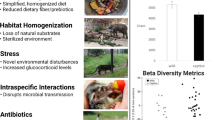Abstract
The Zanzibar red colobus monkey is the only primate, aside from humans, known to eat charcoal in the wild. All age classes and both sexes eat charcoal, but only those groups living in perennial gardens or near human dwellings do so. The habit appears to be transmitted from mother to offspring by imitation, but how it developed in the first place is unknown. Sources of charcoal include charred stumps, logs, and branches, as well as that produced in kilns by humans. These charcoals adsorb organic materials, such as phenolics, particularly well and, as a consequence, remove these compounds, which have the potential to be toxic or interfere with digestion or both. The extreme inertness of charcoal makes it an unlikely source of minerals to the colobus. We conclude that, by eating charcoal, monkeys living in gardens with a high density of food species dominated by exotic trees — Indian almond and mango — are able to exploit this abundant food resource that is high in total phenolic content much more effectively than in the absence of charcoal. The young leaves of these exotic tree species are also very high in protein and highly digestible. The benefits of charcoal eating are most likely due to the fact that charcoal adsorbs phenolics better than proteins. This may explain in large part why the birth rates and population densities of the colobus living in the Indian almond and mango habitat adjacent to the Jozani Forest are significantly higher than those in the ground-water forest. The population density of colobus in this small area is the highest ever recorded for a nonhuman anthropoid (≥700/km 2 ). It may not, however, be a stable situation, as there are indications of higher levels of aggression, lower recruitment into the medium-juvenile size class, and overbrowsing.
Similar content being viewed by others
REFERENCES
Bennett, E. L. (1983). The Banded Langur: Ecology of a Colobine in a West Malaysian Rain Forest, Ph.D. thesis, University of Cambridge, Cambridge.
Clutton-Brock, T. H. (1975). Feeding behaviour of red colobus and black-and-white colobus in East Africa. Folia Primatol. 23: 165–207.
Cooney, D. O. (1995). Activated Charcoal in Medical Applications, Marcel Dekker, New York.
Cooney, D. O., and Struhsaker, T. T. (1997). Adsorptive capacity of charcoals eaten by Zanzibar red colobus monkeys: Implications for reducing dietary toxins. Int. J. Primat. 18 (in press).
Davies, A. G., and Baillie, I. C. (1988). Soil-eating by red leaf monkeys (Presbytis rubicunda) in Sabah, Northern Borneo. Biotropica 20: 252–258.
Halsted, J. A. (1968). Geophagia in man: Its nature and nutritional effects. Am. J. Clin. Nutr. 21: 1384–1393.
Hegnauer, R. (1964). Chemotaxonomie der pflanzen, band 3, Birkhauser Verlag, Basel/Stuttgart.
Hladik, C. M. (1973). Alimentation et activite d'un groupe de chimpanzes reintroduits en forest gabonaise. Terre Vie 27: 343–413.
Hladik, C. M. (1977). A comparative study of the feeding strategies of two sympatric species of leaf monkeys: Presbytis senex and Presbytis entellus. In Clutton-Brock, T. H. (ed.), Primate Ecology: Studies of Feeding and Ranging Behaviour in Lemurs, Monkeys and Apes, Academic Press, London, pp. 324–353.
Izawa, K. (1975). Foods and feeding behavior of monkeys in the upper Amazon basin. Primates 16(3): 295–316.
Johns, T. (1986). Detoxification function of geophagy and domestication of the potato. J. Chem. Ecol. 12: 635–646.
Kay, R. N. B., and Davies, A. G. (1994). Digestive physiology. In Davies, A. G., and Oates, J. F. (eds.), Colobine Monkeys: Their Ecology, Behaviour and Evolution, Cambridge University Press, Cambridge, pp. 229–249.
Marsh, C. W. (1978). Ecology and Social Organization of the Tana River Red Colobus, Colobus badius rufomitratus, Ph.D. thesis, University of Bristol, Bristol, UK.
Mturi, F. A. (1991). The Feeding Ecology and Behaviour of the Red Colobus Monkey (Colobus badius kirkii), Ph.D. thesis, University of Dar es Salaam, Tanzania.
Mturi, F. A. (1993). Ecology of the Zanzibar red colobus monkey, Colobus badius kirkii (Gray, 1968), in comparison with other red colobines. In Lovett, J. C., and Wasser, S. K. (eds.), Biogeography and Ecology of the Rain Forests of Eastern Africa, Cambridge University Press, Cambridge, pp. 243–265.
Oates, J. F. (1978). Water-plant and soil consumption by guereza monkeys (Colobus guereza): A relationship with minerals and toxins in the diet? Biotropica 10: 241–253.
Oates, J. F. (1994). The natural history of African colobines. In Davies, A. G., and Oates, J. F. (eds.), Colobine Monkeys: Their Ecology, Behaviour and Evolution, Cambridge University Press, Cambridge.
Oates, J. F., Waterman, P. G., and Choo, G. M. (1980). Food selection by the South Indian leaf monkey, Presbytis johnii, in relation leaf chemistry. Oecologia 45: 45–56.
Pollock, J. I. (1977). The ecology and sociology of feeding in Indri indri. In Clutton-Brock, T. H. (ed.), Primate Ecology: Studies of Feeding and Ranging Behaviour in Lemurs, Monkeys and Apes, Academic Press, London, pp. 38–69.
Ripley, S. (1970). Leaves and leaf-monkeys: The social organization of foraging in gray langurs. In Napier, J. R., and Napier, P. H. J. (eds.), Old World Monkeys: Evolution, Systematics and Behavior, Academic Press, New York, pp. 481–509.
Schaller, G. B. (1963). The Mountain Gorilla: Ecology and Behavior, University of Chicago Press, Chicago.
Siex, K. S. (1995). The Zanzibar Red Colobus Monkey (Procolobus kirkii): Ecology, Demography and Use of Cocos nucifera, M.Sc. thesis, University of Florida, Gainesville.
Vermeer, D. E., and Ferrell, R. E., Jr. (1985). Nigerian geophagical clay: A traditional anti-diarrhoeal pharmaceutical. Science 227: 634–636.
Waterman, P. G., and Kool, K. M. (1994). Colobine food selection and plant chemistry. In Davies, A. G., and Oates, J. F. (eds.), Colobine Monkeys: Their Ecology, Behaviour and Evolution, Academic Press, New York, pp. 251–284.
Author information
Authors and Affiliations
Rights and permissions
About this article
Cite this article
Struhsaker, T.T., Cooney, D.O. & Siex, K.S. Charcoal Consumption by Zanzibar Red Colobus Monkeys: Its Function and Its Ecological and Demographic Consequences. International Journal of Primatology 18, 61–72 (1997). https://doi.org/10.1023/A:1026341207045
Issue Date:
DOI: https://doi.org/10.1023/A:1026341207045




